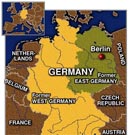Berlin's Tempelhof Airport closes 85-year history
 Berlin - Berlin's fabled Tempelhof Airport ceased 85 years of operations on Thursday, with its last scheduled flight taking to the skies after the city's mayor declared time was up for the site.
Berlin - Berlin's fabled Tempelhof Airport ceased 85 years of operations on Thursday, with its last scheduled flight taking to the skies after the city's mayor declared time was up for the site.
The airport, which is surrounded by multi-storey apartment blocks, was once the entry point for 2.3 million tons of airborne relief during the 1948-49 Berlin Airlift. Future use of the historic site has not been decided.
The airport opened in 1923, became an icon of 20th-century design, secured West Berlin's post-war survival and eked out its last years catering to business flights, claiming the title of world's oldest airport.
Just after 10 pm, the last aircraft, a propeller plane operated by Cirrus Airlines, lifted off for the German city of Mannheim.
Many Berliners were sad that the loss-making airport, where runways are too short to accommodate big modern jets, had to close.
Some guests at the closing ceremony jeered Mayor Klaus Wowereit as he said Berlin needed the land. "We have to look forward," he said.
Outside, 100 conservationists opposed to the closure blew whistles and waved banners in a last protest vigil at dusk.
Two antique planes, a US-made Douglas DC-3, as used in the airlift, and a German Ju-52, a type that carried passengers from 1932 onward for Lufthansa, were set to lumber into the air at midnight in an act to recall Tempelhof's glory days.
Georg Kohne, 51, a Lufthansa pilot assigned to the Ju-52, said: "It's the saddest day of my career."
Three more vintage planes, which required ideal weather to get airborne, were stuck on the ground because of cold and rain. Airport spokesman Ralf Kunkel said that the planes would have to be trucked out if they did not take off by the deadline.
A big new airport in Berlin's green belt is to take over the functions of both Tempelhof and another city airport at Tegel.
Tempelhof is just 4 kilometres from the city centre. Tourists still come to gawk at its vast Nazi-era buildings, including the 1,200-metre-long curved terminal, built in 1934 and now seen by many as a classic of 1930s architecture.
Wowereit insisted that Tempelhof and Tegel must close, so that all airlines land outside the city at Schoenefeld Airport, which is being rebuilt and is to be renamed Berlin Brandenburg International (BBI) in 2011.
Tempelhof's finest hour was during the airlift, when Soviet authorities blocked road, rail and canal transport links into West Berlin. The Allies flew coal and food to Berlin's 2.2 million people for 320 tense days.
Unable to prevail, the Soviets eventually called off the blockade. (dpa)